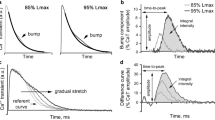Summary
In isolated papillary muscle strips from nonfailing donor hearts (NF) and from the hearts of patients with dilated cardiomyopathy with severe heart failure (NYHA IV), the force-frequency relationship was studied. Experiments were performed under basal conditions and in the presence of 0.01 μM or 0.1 μM isoprenaline and 0.02 μM ouabain. In NF, there was a positive inotropic effect following an increase of the stimulating frequency, whereas in NYHA IV, the force gradually declined under these conditions. Low concentrations (0.01) μM of isoprenaline prevented the negative inotropic effect in NYHA IV, whereas at 0.1 μM the mechanical function deteriorated in NF and NYHA IV. Ouabain had no effect on the force-frequency relationship compared to basal conditions. It is concluded that a reduction of high frequencies does improve the contractility in the failing myocardium. It is not unreasonable to speculate that this mechanism might be involved in the beneficial effects of drugs which reduce the heart rate, such as β-adrenoceptor antagonists and cardiac glycosides, in the condition of congestive heart failure in which the sympathetic tone is high.
Similar content being viewed by others
Abbreviations
- NF:
-
nonfailing myocardium
- DCM:
-
dilated cardiomyopathy
- SEM:
-
standard error of the mean
- Hz:
-
hertz
- NYHA IV:
-
functional class IV heart failure according to the New York Heart Association
- CAMP:
-
cyclic 3′,5′-adenosine monophosphate
References
Böhm M, Beuckelmann D, Brown L, Feiler G, Lorenz B, Näbauer M, Kemkes B, Erdmann E (1988) Reduction of beta-adrenoceptor density and evaluation of positive isotropic responses in isolated, diseased human myocardium. Eur Heart J 9:844–852
Böhm M, Gierschik P, Jakobs KH, Pieske B, Schnabel P, Ungerer M, Erdmann E (1990) Increase of Giα in human hearts with dilated but not ischemic cardiomyopathy. Circulation 82:1249–1265
Bowditch HP (1871) Über die Eigenthümlichkeiten der Reizbarkeit, welche die Muskelfasern des Herzens zeigen. Ber Sächs Ges (Akad) Wiss 652–689
Bristow MR, Ginsburg R, Minobe W, Cubiciotti RS, Sageman WS, Lurie K, Billingham ME, Harrison DC, Stinson EB (1982) Decreased catecholamine sensitivity and beta-adrenergic-receptor density in failing human hearts. N Engl J Med 307:205–211
Bristow MR, Ginsburg R, Umans V, Fowler M, Minobe W, Rasmussen R, Zera P, Menlove R, Shah P, Jamieson S, Stinson EB (1986) β1- and β2-Adrenergic receptor subpopulations in nonfailing and failing human ventricular myocardium: coupling of both receptor subtypes to muscle contraction and selective β1-receptor down-regulation in heart failure. Circ Res 59:297–309
Brodde OE, Zerkowski HR, Borst HG, Maier W, Michel MC (1989) Drug- and disease-induced changes of human cardiac β1- and β2-adrenoceptors. Eur Heart J [Suppl B] 10:38–44
Chidsey CA, Harrison DC, Braunwald E (1962) Augmentation of the plasma noradrenaline response to exercise in patients with congestive heart failure. N Engl J Med 267:650–654
Cohn JN, Levine TB, Olivari MT, Garberg V, Lura D, Francis GS, Simon AB, Rector T (1984) Plasma noradrenaline as a guide to prognosis in patients with chronic congestive heart failure. N Engl J Med 311:819–823
Feldman AM, Copelas L, Gwathmey JK, Philips P, Warren SE, Schoen FJ, Grossman W, Morgan JP (1987) Deficient production of cyclic AMP: pharmacologic evidence of an important cause of contractile dysfunction in patients with end-stage heart failure. Circulation 75:331–339
Feldman AM, Cates AE, Veazey WB, Hershberger RE, Bristow MR, Baughman KL, Baumgartner WA, Van Dop C (1988) Increase of the 40,0001 mol wt pertussis toxin substrate (G protein) in the failing human heart. J Clin Invest 82:189–197
Gwathmey JK, Copelas L, MacKinnon R, Schoen FJ, Feldman MD, Grossman W, Morgan JP (1987) Abnormal intracellular calcium handling in myocardium from patients with end-stage heart failure. Circ Res 61:70–76
Gwathmey JK, Slawsky MT, Hajjar RJ, Briggs GM, Morgan JP (1990) Role of intracellular calcium handling in force-interval relationships of human ventricular myocardium. J Clin Invest 85:1599–1613
Gwathmey JK, Warren SE, Briggs GM, Copelas L, Feldman MD, Phillips PJ, Callahan M Jr, Schoen FJ, Grossman W, Morgan JP (1991) Diastolic dysfunction in hypertrophic cardiomyopathy. J Clin Invest 87:1023–1031
Katz AM (1986) Potential deleterious effects of inotropic agents in the therapy of chronic heart failure. Circulation [Suppl III] 73:184–190
Kirchberger MA, Tada M, Katz AM (1974) Adenosine 3′:5′-monophosphate-dependent protein kinase-Katalyzed phosphorylation reaction and its relationship to calcium transport on cardiac sarcoplasmic reticulum. J Biol Chem 249:6166–6173
Movsesian MA (1988) Calcium uptake and release by cardiac sarcoplasmic reticulum. Heart Failure 10:259–264
Movsesian MA, Bristow MR, Krall J (1989) Ca2+ uptake by cardiac sarcoplasmic reticulum from patients with idiopathic dilated cardiomyopathy. Circ Res 65:1141–1144
Movsesian MA, Colyer J, Wang JH, Krall J (1990) Phospholamban-mediated stimulation of Ca2+ uptake in sarcoplasmic reticulum from normal and failing hearts. J Clin Invest 85:1698–1702
Mulieri LA, Hasenfuss G, Ittleman F, Allen PD, Blanchard EM, Alpert NR (1989) Alterations in the force-frequency. Relation in stage III–IV failing human myocardium (abstract). Circulation 80:4
Neumann J, Scholz H, Döring V, Schmitz W, Meyerinck L v, Kalmar P (1988) Increase in myocardial Gi-proteins in heart failure. Lancet II:936–937
Packer M (1988) Neurohormonal interactions and adaptations in congestive heart failure. Circulation 77:721–730
Thomas JA, Marks BH (1978) Plasma noradrenaline in congestive heart failure. A J Cardiol 41:233–243
Wallenstein S, Zucker CL, Fleiss JL (1980) Some statistical methods useful in circulation research. Circ Res 47:1–9
Author information
Authors and Affiliations
Additional information
Supported by the Deutsche Forschungsgemeinschaft (Bo 896/1-2)
Rights and permissions
About this article
Cite this article
Böhm, M., La Rosée, K., Schmidt, U. et al. Force-frequency relationship and inotropic stimulation in the nonfailing and failing human myocardium: implications for the medical treatment of heart failure. Clin Investig 70, 421–425 (1992). https://doi.org/10.1007/BF00235525
Received:
Revised:
Accepted:
Issue Date:
DOI: https://doi.org/10.1007/BF00235525




